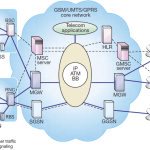Broadband technology, Telecommunications devices, lines, or technologies that allow communication over a wide band of frequencies, and especially over a range of frequencies divided into multiple independent channels for the simultaneous transmission of different signals. Broadband systems allow voice, data, and video to be broadcast over the same medium at the same time. They may also allow multiple data channels to be broadcast simultaneously.
DSL
DSL, in full digital subscriber line, networking technology that provides broadband (high-speed) Internet connections over conventional telephone lines.

DSL
DSL technology has its roots in work done by Bell Communications Research, Inc., in the late 1980s to explore the feasibility of sending broadband signals over the American telecommunications network. The first efforts in this area resulted in another high-speed Internet technology, called integrated services digital network (ISDN). In the early 1990s the first variety of DSL, high-bitrate DSL (HDSL), was rolled out with the intent of being used for on-demand television. Initial efforts looked promising, but the rapidly growing number of channels provided by cable television companies made setting up an on-demand service financially less attractive. Soon after, DSL was repurposed for connecting devices to the Internet. Other varieties of DSL soon followed the creation of HDSL, including the most common type: asynchronous DSL (ADSL). Asynchronous refers to the way that more bandwidth is given to downstream traffic, which comes to the user from the Internet, than to upstream traffic, which goes from the user to the Internet. Traffic on DSL is transmitted over normal telephone lines through a DSL terminal adapter, also known as a DSL modem, which connects a computer or local computer network to the DSL line.
Each DSL user has a dedicated telephone line, so unlike its closest competitor, cable Internet, signing up more neighbourhood customers does not degrade service. However, DSL is limited by distance. A user has to be within a few miles of a telephone switching office for DSL to work, and signal strength degrades even within that distance. In addition, DSL speeds have not improved much since being introduced—typically, they are 128 Kbps (128,000 bits per second) upstream and 512 Kbps downstream, though premium business services may be about 10 times faster—while cable, which is generally less expensive than DSL, offers speeds in excess of 1 Mbps (1 million bits per second) upstream and 16 Mbps downstream.


